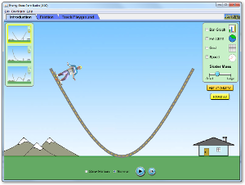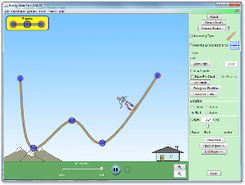|
Momentum >>
|
4.5 - The Work-Energy Theorem
Objectives:
- Understand that work is required to change the kinetic energy of an object.
- To be able to use the work-energy theorem to solve problems
The so-called work-energy theorem stems from the definition of kinetic energy. The kinetic energy of an object is defined as the work required to stop it, or conversely, to accelerate it. We usually just consider the limiting case of moving to stationary or vice versa. However, it can be just that the object changes speed - so the work done is equal to the difference between the initial and final kinetic energies. This is useful as it can provide an easier method of solving an accelerated object problem than using kinematics and dynamics. Note: we must still arrive at the same answer though!
\[W = \Delta KE\]
So, if an object is at the top of a rough slope, it will slide down losing its potential energy, but not all of it will be converted into kinetic energy, so will be transferred to heat via friction. As the kinetic energy at the bottom will be less than if there was no friction, then the object will be slower. The work done by friction can be calculated using \(work = force \times distance\).
\[GPE_{top}=KE_{bottom}+W_{friction}\]
If a moving object is pushed up a hill by an external force, then its final potential energy is the sum of its initial kinetic energy and the work done on raising it. The 'extra' energy has been added by the external force. If springs are included, then the elastic potential energy must be accounted for.
This is the final part of the 'accounting' of the energy before and after an event. Overall, the total energy before must equal to that after. If a force is applied to an object, then the work done by that force increases the net energy. If the object does work on its surroundings then its net energy is reduced. It is always worth pausing and considering whether work has been added or removed from the object. This is known as the First Law of Thermodynamics and we will look at this concept in more detail in Unit 14 - Thermal Physics (AP-2).
\[W = \Delta KE\]
So, if an object is at the top of a rough slope, it will slide down losing its potential energy, but not all of it will be converted into kinetic energy, so will be transferred to heat via friction. As the kinetic energy at the bottom will be less than if there was no friction, then the object will be slower. The work done by friction can be calculated using \(work = force \times distance\).
\[GPE_{top}=KE_{bottom}+W_{friction}\]
If a moving object is pushed up a hill by an external force, then its final potential energy is the sum of its initial kinetic energy and the work done on raising it. The 'extra' energy has been added by the external force. If springs are included, then the elastic potential energy must be accounted for.
This is the final part of the 'accounting' of the energy before and after an event. Overall, the total energy before must equal to that after. If a force is applied to an object, then the work done by that force increases the net energy. If the object does work on its surroundings then its net energy is reduced. It is always worth pausing and considering whether work has been added or removed from the object. This is known as the First Law of Thermodynamics and we will look at this concept in more detail in Unit 14 - Thermal Physics (AP-2).
4.6 - Systems
One of the BIG differences with the new AP Physics 1 course is that it likes to ask about SYSTEMS. For example, in the old days we would talk about the work done by raising an apple from the ground and it gains GPE. We rarely consider the Earth as it essentially does not move. But if we were to consider both the apple and the Earth simultaneously, does the system gain, lose or have the same energy as before? One of the ways to think about this is to consider if work has had to be done to or from outside the system. I personally find this rather tricky!
Momentum >>

